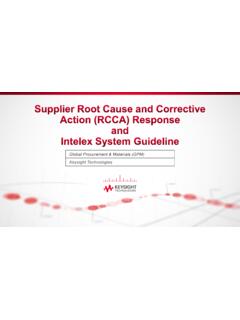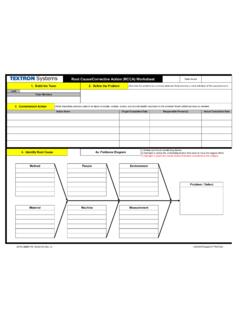Transcription of Using TapRooT Root Cause Analysis Final
1 Copyright 2019 by System Improvements, Inc. All rights reserved. 1 Using TapRooT root Cause Analysis to Investigate Precursor Incidents and Major Accidents By Mark Paradies Why Do You Need Advanced root Cause Analysis ? You can use TapRooT root Cause Analysis to investigate a major accident, but no one wants to investigate a: Fatality Major environmental damage Serious injury Major quality issue or product recall Regulatory issue Serious production outage That s why we need to stop major accidents before they happen. How can you find and fix the problems that may lead to a major accident before it happens? By fixing the root causes of the precursor incidents that warn us of impending failures. I ve never seen a major accident that didn t have several, or perhaps a dozen, precursor incidents that could have been investigated and used to solve the problems and thereby, stop the major accident.
2 Why do major accidents happen? Because people ignore the warning signs. They don t invest the effort, or they don t have the knowledge, to find the root causes of the problems and fix them before the next major accident occurs. That s why we developed the TapRooT root Cause Analysis System. To help people go beyond their current knowledge to find and fix the root causes of incidents. TapRooT helps companies learn from their experiences and prevent major accidents. This white paper describes how the TapRooT System can be used to find the root causes of a medium-risk environmental incident at a chemical plant. We will compare the solutions developed Using TapRooT to the real corrective actions applied after a similar incident at a commercial facility. Plus, we will provide an overview of how TapRooT root Cause Analysis is used by companies and the results achieved solving their toughest problems.
3 Two TapRooT Processes The TapRooT System is documented in a series of books1,2,3,4,5,6,7,8,9,10. To keep the TapRooT System as easy to use as possible, we created two separate processes: one for precursor incidents and one for major accidents. What is a precursor incident? Copyright 2019 by System Improvements, Inc. All rights reserved. 2 Precursor Incident Minor incidents that could have been a major accident if one or two more Safeguards would have failed. The simple process was designed to make root Cause Analysis as easy as possible (less time-consuming) while still guiding investigators to the real root causes and helping them develop effective corrective actions. The process for investigating these low-to-medium risk precursor incidents is shown below. The process starts by applying the SnapCharT Diagram (example shown later) to discover what happened.
4 When you understand what happened, you are ready to decide if there is something important to learn. If not, you stop the investigation. Stopping the investigation once you understand the incident isn t worth investigating can save time and avoid the wasted effort of implementing unnecessary corrective actions. Copyright 2019 by System Improvements, Inc. All rights reserved. 3 If a precursor incident is worth investigating, the next step is to identify the incident s Causal Factors. A Causal Factor is: Causal Factor A mistake, error, or failure that, if corrected, would have prevented the incident or mitigated its consequences. An incident may have several Causal Factors. Each Causal Factor needs to be analyzed to find its root Cause (s). Identifying the Causal Factor s root causes is the next step. The root Cause Tree Diagram is used to guide investigators to root causes .
5 The process is explained later in this white paper. Finally, the corrective action Helper Guide/Module is used to help investigators develop effective fixes ( corrective actions) for the root causes . That s the simple TapRooT Process. The TapRooT 7-Step Major Investigation Process is shown Copyright 2019 by System Improvements, Inc. All rights reserved. 4 What is the difference between the simple investigation process and the major investigation process? 1. More steps. The major investigation starts with planning and also looks for Generic causes . 2. Optional techniques. The major investigation process includes the Equifactor , CHAP, and Change Analysis techniques to help in the evidence collection phase of the investigation. 3. No option to stop. In the simple investigation, we can stop if there isn t anything important to learn. But for a major accident, you need to complete the investigation.
6 Stopping isn t an option. For more about the TapRooT 7-Step Major Investigation Process and investigating major accidents, read: Using TapRooT root Cause Analysis for Major Precursor Incident Investigation Using the TapRooT System The following is an example of the use of the TapRooT System to analyze a medium-risk, environmental incident (Fish Kill) at a chemical plant. The incident has been de-identified and is not intended to represent an actual event at any particular location. This investigation was performed Using the simple (low-to-medium risk) investigation process shown on page 2. To shorten this example, the information collection portion of the investigation is not shown. Rather, use of the TapRooT System is only demonstrated for the evidence organization (what happened), root Cause Analysis (why it happened), and the development of corrective actions (how to improve performance).
7 The three main tools in this example are the: SnapCharT Diagram root Cause Tree Diagram corrective action Helper Module Initial Incident Description During a normal night shift at a process plant, fish were killed when a temporary water treatment unit overheated and released hot, low pH water to one of the plant's outfalls. An investigation that included a contractor representative (contract personnel were operating the rental temporary water treatment unit) was conducted Using the TapRooT System. The preliminary sequence of events is shown on a SnapCharT Diagram on the next page. Copyright 2019 by System Improvements, Inc. All rights reserved. 5 Results of Additional Investigation After: Interviews with all contract operators and their supervisors, Discussions with the temporary water treatment unit vendor's engineers, Interviews with plant personnel at the process plant unit, Interviews with procurement personnel, and Interviews with operations management, a more detailed SnapCharT with Causal Factors (indicated by black triangles) was developed and is shown below and on the next two Copyright 2019 by System Improvements, Inc.
8 All rights reserved. 6 Continued on next page Copyright 2019 by System Improvements, Inc. All rights reserved. 7 The four Causal Factors are marked with a triangle and include all the attached information. Each of the Causal Factors were analyzed for root causes Using the root Cause Tree Diagram and root Cause Tree Dictionary. The following is an Analysis of the Causal Factor: Operator did not fix Cause of high temperature. Analyzing a Causal Factor In an actual investigation, all the Causal Factors would be analyzed to find their root causes . However, to keep this white paper short, we will only explain the Analysis of a single Causal Factor Operator did not fix Cause of high temperature. The investigator starts at the top of the root Cause Tree Diagram (shown below, the complete root Cause Tree Diagram is available in Using the Essential TapRooT Techniques to Investigate Low-to-Medium Risk Incidents3) and works down the tree Using a process of selection and elimination.
9 The investigator thus asks and answers questions to identify the specific root causes for this Causal Factor. In this case, the Causal Factor Operator did not fix Cause of high temperature was identified as a Human Performance Difficulty (one of the four major problem categories at the top of the root Cause Tree ) and the other three difficulty categories were eliminated. Operator did not fix Cause of high temperature Copyright 2019 by System Improvements, Inc. All rights reserved. 8 When the Human Performance Difficulty was identified, the Tree guided the investigator to a set of 15 questions called the Human Performance Troubleshooting Guide (part of the Tree's embedded intelligence). The first of the 15 questions of the guide is shown below. The 15 questions guide the investigator to select which of the seven human performance-related Basic Cause Categories to investigate further.
10 The seven categories are: Procedures Training Quality Control Communications Management System Human Engineering Work Direction Each category indicated by a "Yes" answer to the questions in the Human Performance Troubleshooting Guide was investigated further to see if it could be eliminated or if one or more Near- root causes and related root causes contributed to the problem (and thereby "caused" the incident). The Human Engineering Basic Cause Category is shown below. Copyright 2019 by System Improvements, Inc. All rights reserved. 9 For the Operator did not fix Cause of high temperature Causal Factor, four of the 15 questions were answered "Yes." The 15 questions guided the investigator to review the following Basic Cause Categories: Human Engineering Work Direction Management System Procedures A screen shot (from the TapRooT VI Software) of one of these categories (Human Engineering) with the Analysis completed is shown below.






